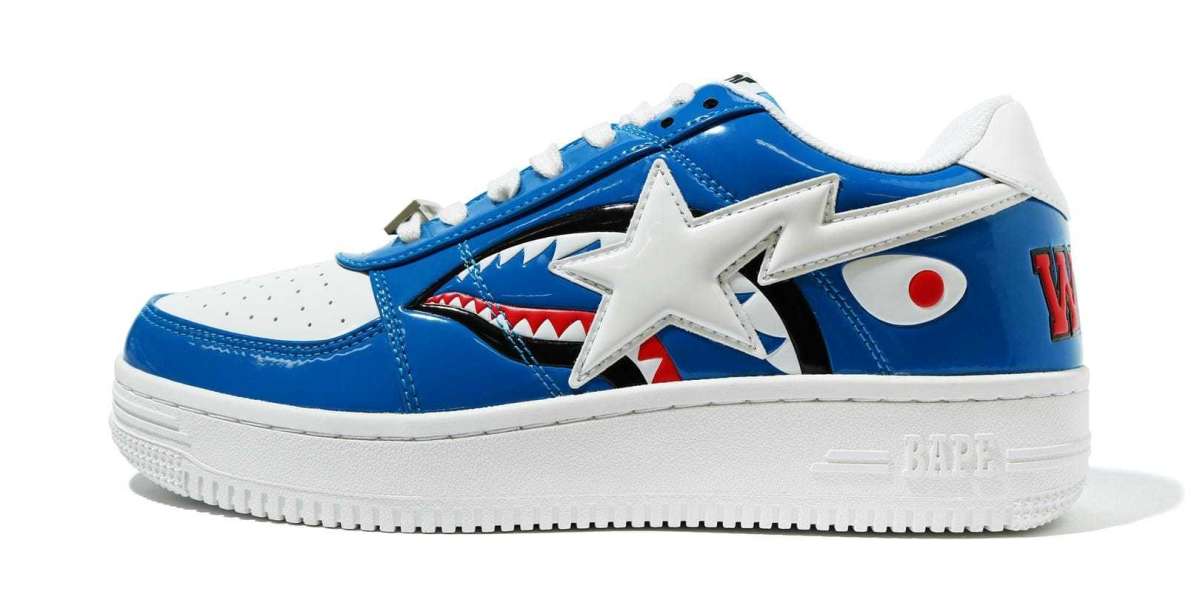BAPESTA, the iconic sneaker line from Japanese streetwear giant A Bathing Ape (BAPE), has earned its place as a revolutionary symbol in the global sneaker community. With its bold aesthetics, flashy colorways, and unmistakable star-shaped logo, BAPESTA transcends ordinary sneaker culture and stands at the intersection of fashion, music, and art. Born in the early 2000s under the creative direction of Nigo, BAPESTA reshaped how streetwear is defined and consumed. It became a cultural artifact, especially in the hip-hop and fashion-forward communities that admired its rebellious spirit.
BAPESTA Sneaker History and Evolution
The history of BAPESTA sneakers began in 2002 when Nigo took inspiration from the Nike Air Force 1 silhouette, putting a BAPE twist on it. Instead of the Swoosh, BAPESTA featured the "STA" star logo and embraced glossy patent leather in vivid colors that immediately set it apart. While some considered it a knockoff, true fans saw it as a reinterpretation—an homage turned into a creative reimagining. BAPESTA became a hit not only in Japan but also in global markets, especially in the United States, where artists like Pharrell Williams, Kanye West, and Lil Wayne proudly wore the sneakers. Over the years, the design has remained rooted in its original shape while evolving through countless collaborations and limited releases.
Why BAPESTA is Iconic in Streetwear Culture
What makes BAPESTA iconic isn’t just the design. It’s the cultural power it carries. In the early 2000s, BAPE and BAPESTA sneakers were rare and difficult to find outside Japan. This exclusivity built a sense of hype and mystique. In a time before sneaker apps and resale giants, owning a pair of BAPESTAs signaled global streetwear awareness and fashion-forward individuality. The sneakers became a canvas of self-expression. Neon greens, candy pinks, camo patterns, and gradient hues weren’t just stylistic choices; they were statements. Wearing BAPESTA was a way to stand out, to challenge the ordinary, and to showcase allegiance to a bold, rebellious lifestyle.
BAPESTA vs Air Force 1: Similarities and Differences
At first glance, the similarities between BAPESTA and Air Force 1 are undeniable. Both sneakers share a low-top build, thick sole, and similar paneling structure. However, where the Air Force 1 maintains a clean and athletic aesthetic, BAPESTA leans into its loud and expressive nature. The materials on BAPESTA often include patent leather, glossy finishes, and multi-color designs, whereas the Air Force 1 typically favors matte leather in muted tones. Another key difference lies in the branding. Nike’s Swoosh is globally recognized as athletic heritage, while BAPESTA’s star is a symbol of high-end street culture. In essence, the Air Force 1 represents tradition, while BAPESTA signifies disruption.
The Influence of Hip-Hop on BAPESTA Popularity
BAPESTA found its strongest resonance within the hip-hop world. Pharrell Williams was among the first major American artists to embrace the brand, often seen in head-to-toe BAPE. His endorsement helped bridge the gap between Japanese streetwear and Western pop culture. Kanye West’s collaboration with BAPE, especially the release of the Kanye BAPESTA with his cartoon bear, became legendary in sneaker folklore. Lil Wayne and Soulja Boy further carried the legacy, flaunting BAPESTAs in music videos and public appearances. The sneakers weren’t just footwear—they became trophies of success, symbols of musical influence, and badges of originality.
Collaborations That Elevated BAPESTA Status
BAPESTA has collaborated with some of the most influential figures and brands in fashion and entertainment. From Kanye West to Marvel Comics, from Comme des Garçons to Undefeated, each collaboration has elevated the BAPESTA legacy. These limited-edition releases often sell out in seconds and are resold at premium prices, adding to their allure. The collaborative nature of BAPESTA reflects BAPE’s philosophy: fashion is not isolated. It interacts, evolves, and reinvents itself through partnerships. These collabs also enable BAPESTA to stay relevant, tapping into different creative spheres and fanbases with every release.
Design Language and Visual Identity of BAPESTA
The design of BAPESTA sneakers is as unmistakable as it is bold. The signature star logo, often outlined in contrast colors, cuts across the side panel like a lightning bolt. The color schemes are fearless—pastel blue against cherry red, jungle camouflage against bright yellow, and even metallic silver editions that seem to shine under every light. The word “BAPE” is usually emblazoned on the heel tab or tongue, anchoring the brand identity. Beyond the shoe, the box, tissue paper, and packaging often carry unique designs that collectors admire just as much as the footwear itself.
The Collector’s Market and Resale Value of BAPESTA
BAPESTA sneakers have become prized collectibles over the years. Due to limited production and exclusive drops, certain BAPESTA models fetch thousands of dollars on the resale market. This collector value is amplified by the nostalgia attached to early 2000s hip-hop and fashion. Many sneakerheads are on the hunt for vintage BAPESTAs from the Nigo era, viewing them as grails. Owning a rare pair is not just about aesthetics—it’s about owning a piece of streetwear history. Even newer releases attract instant demand, thanks to the loyalty and hype surrounding the brand.
BAPESTA’s Role in the Modern Sneaker Landscape
In today’s era of performance sneakers, minimalism, and sustainable design, BAPESTA continues to stand out as a defiant expression of maximalist fashion. Its refusal to conform is part of its appeal. While other brands chase comfort and tech upgrades, BAPESTA embraces heritage, attitude, and nostalgia. It reminds the sneaker world that not every shoe has to be about running faster or walking lighter. Sometimes, it’s about making a visual and cultural statement. The BAPESTA remains an outlier in the best possible way—a vibrant reminder of when fashion was louder, riskier, and driven by pure creativity.
Conclusion: The Future of BAPESTA in Global Fashion
BAPESTA has weathered over two decades of evolving trends and still holds a respected place in streetwear and sneaker culture. Its history, celebrity endorsements, daring design language, and exclusive collaborations have carved out a unique identity. As BAPE continues to reimagine BAPESTA for new generations—while respecting its roots—the sneaker is positioned to remain a timeless icon.
 Meet Ups
Meet Ups
 Experiences
Experiences
 Learning Center
Learning Center
 Accommodation
Accommodation
 Roomie
Roomie
 Ride
Ride
 Spread the Word
Spread the Word
 Student Bazaar
Student Bazaar
 Jobs
Jobs
 Blogs
Blogs
 About StudentInsta
About StudentInsta

